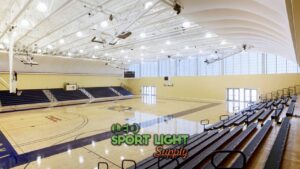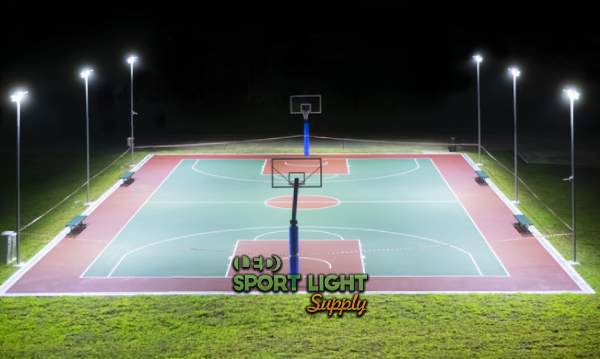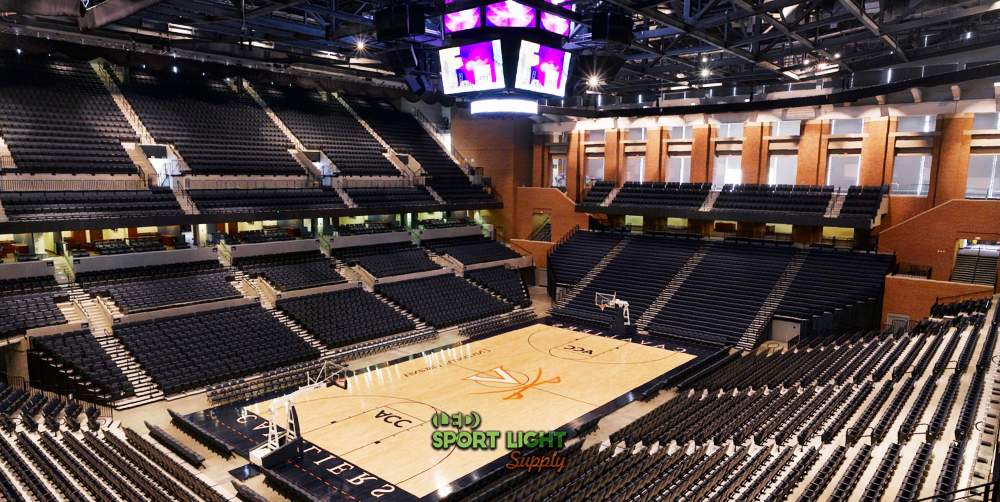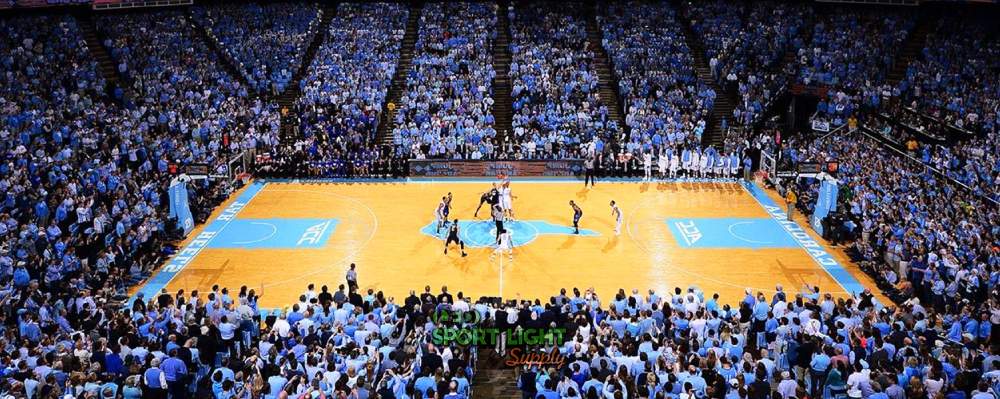
Both indoor and outdoor courts require a well-thought-out lighting design to ensure that the playing surface is uniformly illuminated, allowing players to perform to their best ability. The intensity, distribution, and quality of light on the court are all factors that contribute to creating an optimal atmosphere for both competitive games and practice sessions.
Table of Contents
Toggle| Court Type | Lux Level | Lighting Requirements |
|---|---|---|
| Indoor Basketball Courts | 500 lux | Consistent lighting to eliminate shadows and bright spots, ensuring clear visibility of the basketball, court markings, and players. |
| Outdoor Basketball Courts (Recreational) | 100-300 lux | Basic illumination to supplement natural daylight for visibility of the basketball, court markings, and players. |
| Outdoor Basketball Courts (Professional) | 500 lux | Sufficient lighting for competitive play, ensuring uniform illumination and clear visibility for players and spectators. |
| Professional Outdoor Courts (Competition/Televised) | 1000+ lux | Higher lighting for broadcast-quality visibility and uniformity, supporting fast-paced gameplay and large audiences. |
 For indoor basketball courts, the lighting needs are generally more controlled due to the enclosed space. The primary objective is to provide a consistent level of illumination across the entire court to minimize shadows and bright spots that could interfere with the game. The recommended illuminance level for indoor basketball courts is typically around 500 lux, a measure of light intensity that ensures sufficient brightness for players, coaches, and spectators alike. This level of lighting is necessary to ensure that athletes can clearly see the basketball, markings on the floor, and their teammates, which are all crucial for accurate gameplay.
For indoor basketball courts, the lighting needs are generally more controlled due to the enclosed space. The primary objective is to provide a consistent level of illumination across the entire court to minimize shadows and bright spots that could interfere with the game. The recommended illuminance level for indoor basketball courts is typically around 500 lux, a measure of light intensity that ensures sufficient brightness for players, coaches, and spectators alike. This level of lighting is necessary to ensure that athletes can clearly see the basketball, markings on the floor, and their teammates, which are all crucial for accurate gameplay.
In addition to the illuminance level, uniformity in the lighting is also an important consideration. Poorly distributed lighting can lead to certain areas of the court being over-illuminated while others remain too dim, which disrupts both visual comfort and performance. Achieving uniform lighting across the court helps to eliminate these discrepancies and ensures that the entire playing surface is equally visible.
 Outdoor basketball courts, on the other hand, face different challenges when it comes to lighting. Natural light from the sun plays a large role in outdoor courts, meaning artificial lighting must supplement the ambient conditions. The lighting needs for outdoor basketball courts vary depending on the level of play and the specific requirements of the location. Recreational courts, for example, may not need as much illumination as professional or competition courts. However, the same principle of uniform illumination applies, ensuring players have adequate light to see the ball, the court markings, and their teammates.
Outdoor basketball courts, on the other hand, face different challenges when it comes to lighting. Natural light from the sun plays a large role in outdoor courts, meaning artificial lighting must supplement the ambient conditions. The lighting needs for outdoor basketball courts vary depending on the level of play and the specific requirements of the location. Recreational courts, for example, may not need as much illumination as professional or competition courts. However, the same principle of uniform illumination applies, ensuring players have adequate light to see the ball, the court markings, and their teammates.
For professional outdoor basketball courts, a lighting level of 500 lux is typically recommended. However, certain competitions may require higher levels of brightness, especially if the game is being broadcasted or watched by large audiences. In any case, uniformity is just as important for outdoor courts as it is for indoor ones, and the lighting design must take into account the impact of environmental factors like weather and the position of the sun at different times of day.

In recent years, LED lighting has become the preferred choice for basketball courts, both indoors and outdoors. The benefits of using LEDs over traditional lighting sources such as incandescent or halogen bulbs are numerous, making LEDs an ideal solution for ensuring high-quality illumination on sports courts.
One of the most significant advantages of LED lighting is its energy efficiency. Traditional lighting technologies, like incandescent bulbs, convert much of the energy they consume into heat, leading to higher energy usage and greater environmental impact. In contrast, LEDs produce very little heat and are highly efficient at converting electrical energy into light. This energy efficiency translates to lower operating costs, as LED lights use much less power than their traditional counterparts. In the context of basketball courts, where multiple light fixtures may be required, switching to LED lighting can lead to substantial savings on electricity bills over time.
Another key benefit of LEDs is their long lifespan. Unlike incandescent or halogen bulbs, which require frequent replacement due to their relatively short lifespan, LED lights can last up to 150,000 hours or more. This longevity significantly reduces the frequency of replacements, thereby lowering maintenance costs and minimizing disruptions to gameplay. For basketball courts, especially those used frequently for both practices and competitions, this reduced need for replacement is an important consideration, as it means less downtime and fewer service interruptions.
In addition to their energy efficiency, LEDs are also a more sustainable lighting option. They consume far less energy, which helps reduce the carbon footprint of sports facilities. Moreover, LED lights do not contain hazardous materials like mercury, which is found in many traditional lighting options, such as fluorescent lamps. This makes LEDs a safer, environmentally friendly choice, supporting the broader trend of sustainability in sports facility management.
Achieving uniform lighting on a basketball court is one of the most important aspects of designing an effective lighting system. Poorly designed lighting can result in areas that are too bright or too dim, which can lead to visual discomfort for players, coaches, and spectators. This lack of uniformity can have a direct impact on the game, affecting players’ ability to track the ball, identify court markings, and judge distances.
LED fixtures are particularly well-suited to achieving high-quality light distribution on basketball courts. Their controlled beam angles and advanced optical designs allow for the precise placement of light, ensuring that the entire playing surface is evenly illuminated. Unlike traditional lights, which may produce harsh shadows or overly bright spots, LEDs can be configured to minimize these discrepancies and provide consistent brightness across the court.
The uniformity ratio, which measures the consistency of light distribution, is often a key design criterion for sports lighting. A common standard for basketball courts is a uniformity ratio of at least 0.7, which ensures that the brightness levels across the court are well balanced. LEDs are adept at meeting this requirement due to their ability to provide consistent lighting over long distances without significant variation.
Another factor to consider when designing basketball court lighting is glare, which can be distracting and even dangerous for players. Glare occurs when light is directed in such a way that it causes discomfort or impairs vision. For athletes, this can make it difficult to track the ball or react quickly to fast-moving plays. Glare can also impact spectators, leading to a less enjoyable viewing experience.
LEDs are specifically designed to reduce glare, thanks to the use of optical lenses, diffusers, and carefully controlled beam angles. These features allow the light to be directed where it is needed, reducing the likelihood of direct light hitting players or spectators in ways that cause discomfort. By minimizing glare, LEDs improve both the performance and safety of basketball players, as well as the experience for those watching the game.
The color temperature of lighting refers to the warmth or coolness of the light emitted by the bulbs, which is measured in Kelvins (K). The color temperature can have a significant impact on the visibility and ambiance of a basketball court. For sports such as basketball, it is typically recommended to use lighting with a cooler color temperature, ranging from 5000K to 6000K.
LED lights within this color temperature range are designed to mimic natural daylight, which enhances contrast and makes it easier for players to distinguish the ball, court markings, and other players. This is particularly beneficial in a fast-paced sport like basketball, where players need to quickly react to changing situations and judge distances with precision. A cool color temperature of around 6000K creates a bright, crisp environment that helps improve visibility without causing eye strain or fatigue.
For indoor basketball courts, this cooler color temperature helps to create a vibrant, daylight-like atmosphere, which is conducive to high-performance play. Similarly, outdoor courts that require artificial lighting benefit from these cooler temperatures, especially during evening or night games when natural light is absent.

The shift to LED lighting in sports facilities is not only about improved performance but also about contributing to environmental sustainability. Traditional lighting technologies consume more power and have a larger environmental impact, both in terms of energy usage and the materials used in their manufacture. LEDs, on the other hand, use significantly less energy, reducing the overall carbon footprint of sports facilities.
For basketball courts, especially those used frequently for both practices and games, the energy savings provided by LEDs can be substantial. The lower energy consumption of LEDs means lower electricity bills, which can lead to significant long-term savings for facility owners. These savings can be reinvested into other aspects of the sports facility or used to fund further sustainability initiatives.
LEDs are also a safer and more environmentally friendly lighting choice due to the absence of harmful substances like mercury. Many older lighting technologies, such as fluorescent bulbs, contain mercury, which can be harmful if the lights are broken or disposed of improperly. Since LEDs do not contain such materials, they pose less risk to the environment and human health, making them a safer choice for sports facilities looking to adopt more sustainable practices.
One of the most compelling reasons for choosing LED lighting for basketball courts is the long lifespan of these fixtures. LEDs are known for their durability and extended operational life, which can reach up to 150,000 hours or more. This significant lifespan translates to fewer replacements and less frequent maintenance, which is especially beneficial for high-traffic environments like basketball courts.
The durability of LED lights reduces the need for frequent replacements, which can be costly and disruptive. On a basketball court, the need to replace lighting fixtures can interfere with scheduled practices and games, causing inconvenience for players and staff. With LEDs, facility managers can avoid this issue for years, ensuring that the court remains well-lit and operational without constant upkeep.
LED lights are designed to withstand the demands of both indoor and outdoor environments. They are resistant to impacts, vibrations, and temperature fluctuations, making them suitable for use in basketball courts that may be exposed to different weather conditions. Whether used for outdoor games or in a high-traffic indoor facility, LED lights maintain their performance over time, further reducing maintenance costs and ensuring a reliable lighting solution.
When it comes to designing lighting systems for basketball courts, the goal is not just to meet technical specifications but to create an environment that enhances the overall experience for players and spectators. Lighting has a significant influence on the performance of athletes, and LEDs, with their precise control over light distribution and color temperature, can help optimize this experience.
One of the ways in which LED lighting can improve player performance is by enhancing visual clarity. The ability to clearly distinguish the basketball from the court, as well as track the movements of teammates and opponents, is essential for fast-paced games. With LEDs providing a high level of brightness and uniformity, players can better judge distances, anticipate ball trajectories, and make accurate passes and shots. In the absence of distracting shadows or glare, athletes can perform with greater precision and confidence.
Furthermore, the cooler color temperatures offered by LEDs—closer to natural daylight—help reduce eye fatigue. This is particularly beneficial during extended practice sessions or long games, where players need to remain sharp and focused. Over the course of a game, lighting that minimizes eye strain allows players to maintain their performance levels and reduces the likelihood of visual errors.
LED lighting also enhances the experience for spectators. Whether watching a game in person or via broadcast, clear and uniform lighting helps spectators see every detail of the action, creating an immersive viewing experience. Proper lighting ensures that players’ movements are visible and that court markings are distinct, allowing fans to follow the game without visual obstructions.
Moreover, the ability to adjust the brightness and color temperature of LED lighting can also be used creatively to highlight key moments or create specific moods during games. In professional and televised basketball events, lighting can be manipulated to produce dramatic effects during introductions, halftime shows, or celebrations, adding a layer of excitement for the audience.
One of the most disruptive elements in sports lighting is glare, which can distract both players and spectators. As mentioned earlier, LEDs are designed with advanced glare-reducing technology, such as diffusers and optical lenses, to direct light exactly where it is needed. By preventing direct light from causing discomfort, LEDs help maintain a focus on the game itself rather than on the surrounding lighting conditions. For players, this means less visual discomfort, allowing them to stay fully engaged in the action. For fans, this means an uninterrupted viewing experience with no distracting reflections or hotspots.
The benefits of LED lighting for basketball courts are undeniable, offering a wide range of advantages in terms of energy efficiency, performance enhancement, and sustainability. LEDs provide uniform illumination, reduce glare, and improve visibility for both players and spectators. They are a more environmentally friendly and cost-effective option compared to traditional lighting sources, helping sports facilities reduce their carbon footprint and operating expenses. With advancements in technology and ongoing innovations, LED lighting will continue to play a central role in shaping the future of basketball court lighting, improving both the playing experience and the overall sustainability of sports facilities.
Drop us a line to receive a free lighting design